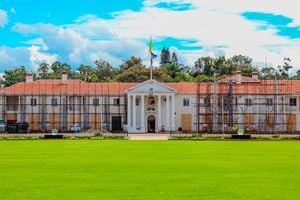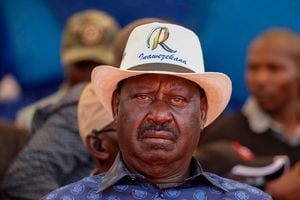Fights erupt as investors scramble for land in Isiolo

Ms Margaret Wanyomwe wails outside her compound which was razed down by protesters in Chechelesi Estate, Isiolo town. The residents were protesting against the killing of three farmers by suspected Turkana gunmen in Tigania East District. Photo/HASSAN HUKA
A week rarely passes in Isiolo without militias killing villagers and displacing families around the town as politically tinged flare-ups continue.
Some 298 people have been killed by bandits since 2009 when the tribal hostilities flared-up in the Isiolo triangle. Over the same period, more than 12,000 livestock have been stolen by raiders.
The Isiolo triangle comprises Isiolo County, as well as Samburu East in Samburu County and Tigania East and Igembe North districts in the wider Meru region.
25,000 animals stolen
Statistics at the Isiolo district peace and conflict resolution committee offices show that in 2009, about 165 people were killed and 9,000 animals stolen while the following year the number of those killed was down to 68 and livestock stolen 3,000.
In 2011, 65 people were felled by bandits and 25,000 animals stolen.
According to Isiolo DPC chairman Diida Golicha, lack of proper land tenure policy and regulations are the major factor fuelling conflict in Isiolo County.
Mr Golicha observes that the proposal to elevate Isiolo to a resort city and communications hub has created a sudden high demand for land.
He says that politicians took the advantage of the volatile land issue to incite their communities to “protect their land” from intruders out to grab land.
Mr Golicha points out that such argument created assumptions among communities residing in Isiolo West that the government will pay them for their land when displaced to create space for resort city.
He continued: “Leaders created the impression that the land would be bought directly from their community by investors or government through county council. Thus communities fight to displace each other forcefully.”
Isiolo resort city will occupy the 6,000 acres at the Kipsing gap locally referred to as Mlango.
Because the area is a common grazing area for the pastoralist communities in Isiolo Central Division, some residents feel uncomfortable with other communities they perceive to be intruders.
And how the locals acquired guns to fight deadly battles in their bid to uproot each other was a question that Mr Golicha blames the government for.
He says that in 2009 and 2011, hundreds of guns were issued to residents under the guise of equipping homeguards in hotspots to avert raids, but the guns fell into wrong hands.
A UNOCHA/UNHCR draft report of November 2011 titled “Current violence affecting vulnerable persons in Isiolo: Analysis and recommendations for follow-up”, paints a grim picture of the security situation as it claims that the Kenya military trained Borana fighters as an anti-Al Shabaab force.
The report states that more than 3,000 of the fighters deserted the military operation with their arms and some of them were taking part as mercenaries in the local conflict.
This allegation was rubbished by the police. Eastern provincial police officer Marcus Ochola questioned the authenticity of the UNOCHA/UNHCR report, asking why the officers sidelined the security agencies when investigating the incidents.
Further, he asked why they did not share their findings with police for security action.
But Livestock Development minister Mohamed Kuti claims that the tribal clashes in Isiolo have the ingredients of expansionist ideology and politics sauced with incitements to violence by some leaders.
While addressing Isiolo residents in October last year, Dr Kuti blamed a community conservancy for blocking land.
This claim is supported by the UNOCHA/UNHCR draft report as it states that some communities contest the establishment of the conservancy since they were not involved in its creation.
Internal Security minister
At the same meeting, Internal Security minister George Saitoti warned leaders that the government would not allow any community to excise land as conservancies and prevent others from using it.
However, local politician Joseph Samal disputes the argument that politics influences conflict in Isiolo.
While he concurs with other leaders on the lack of land tenure policy as fanning clashes, he observes that outsiders who are interested in grabbing land are behind financing the conflict in their bid to displace a section of Isiolo residents.
Cattle rustling and tribal clashes are not new to the residents of Isiolo triangle, but the new trends where attackers kill people and leave without stealing anything is getting security agencies concerned.
The government is keen to contain the violence, according to Upper Eastern Deputy provincial commissioner Isaiah Nakoru.
Mr Nakoru says a disarmament programme will start this year to rid the area of illicit firearms. He warns arms merchants of dire consequences when found.
According to former Isiolo OCPD Augustine Nthumbi, there has been high wave of gun-running in the area following several raids after 2010 disarmament programme in Isiolo.
The police, he added, had apprehended eight gun merchants transporting guns and bullets to Isiolo town and recovered more than 1,000 bullets and 20 guns.
“Over the past five months police have killed three arms traders in fire exchange as police try to arrest them. The vice is on the rise here,” said Mr Nthumbi.
Further, leaders suspected of inciting their communities have over the past four months been arrested and prosecuted in courts.
The arrests toned down hostilities among the warring communities for fear of apprehension. This move brought calm to Isiolo.




